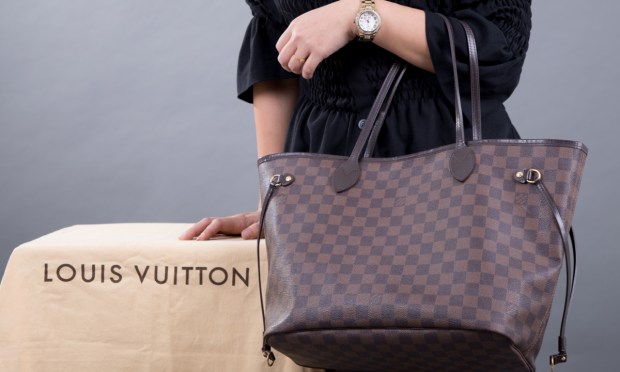Louis Vuitton Channels Hermes by Creating Neverfull Bag Waiting List

Is Louis Vuitton luxury? Depends who you ask and what products you’re looking at. With that even a question among luxury consumers, Louis Vuitton is taking a page out of the Hermès playbook to reclaim its luxury status through one its most sought-after bags, the Neverfull.
When it comes to defining what luxury is, Hermès has mastered the concept, not only by establishing top-tier pricing but also by deliberately cultivating scarcity and waitlists for their most coveted items like the Birkin and Kelly bags. Louis Vuitton has taken note of this approach, but is it too late to emulate the same level of success?
Since its debut in 2007, the Louis Vuitton Neverfull has earned its reputation as a timeless piece, competing with the spacious and adaptable Goyard Saint-Louis Tote, which has been a staple since the 1930s. However, the Neverfull has also become an entry point into the world of designer goods for many individuals, making it a popular choice within the luxury market.
Louis Vuitton is taking steps to diminish the availability of the Neverfull bag. Consequently, this item is now exclusively accessible through alternative purchasing methods, with online and in-store direct purchases no longer available.
The coated canvas tote can now be acquired solely through a waitlist. Once a prospective buyer receives notification regarding the bag’s availability, they must finalize the purchase within 24 hours at a physical store. Failure to do so will result in the bag being offered to the next buyer on the waitlist.
Although the limited edition bag will continue to be available through physical stores and online, obtaining it through regular retail channels is expected to become significantly more difficult. Louis Vuitton is shifting its focus toward creating anticipation and excitement for its leather goods by introducing limited-edition collections.
This decision aligns with the ongoing strategy of luxury brands to implement scarcity tactics, aimed at increasing prices and maximizing profit margins.
Chanel Embraces Boutiques, Raises Prices
Chanel, following in the footsteps of Hermès, has also made headlines by raising the prices of its iconic bags.
According to Chanel Chief Financial Officer Philippe Blondiaux, the price increases in 2023 were attributed to currency fluctuations and inflation. However, Blondiaux also acknowledged that the brand’s emerging strategy includes intentional price increases.
Throughout the years, customers have grown accustomed to the biannual price increases as an established practice. When asked about the rationale behind these adjustments in an interview with WWD, Blondiaux stated that Chanel has a longstanding tradition of revising its prices twice a year. He emphasized that this practice has been consistently maintained by the brand and is intended to continue in the future.
In May 2022, Chanel further enhanced the exclusivity of its brand by introducing dedicated private stores catering to its clientele.
Following a surge in revenue, Chanel revealed that its earnings for the year had escalated by 50% compared to 2021, reaching $15 billion. This growth can be attributed to the performance of its ready-to-wear, jewelry and watch divisions, surpassing pre-pandemic levels. The announcement of the dedicated private stores followed shortly after these results.
To better cater to clients, Chanel also revealed that it would introduce exclusive boutiques in select Asian cities as a priority in 2023, Blondiaux announced. This move aims to provide heightened support and personalized experiences for Chanel’s clientele.
“Our biggest preoccupation is to protect our customers and, in particular, our preexisting customers,” Blondiaux said. “We’re going to invest in very protected boutiques to service clients in a very exclusive way.”
Saks and Gucci Follow Suit
While Saks and Gucci have not created waiting lists, they are leaning into exclusivity by providing special services for top paying clients.
In April, PYMNTS reported that Saks was expanding its top-client program, Saks Limitless, which offers its members access to luxury fashion through a range of unique services and benefits.
Since the introduction of its customized digital segment for eCommerce customers in 2021, Saks Fifth Avenue’s Saks Limitless program has experienced substantial growth. The program reportedly serves thousands of clients within the Saks Fifth Avenue ecosystem, focusing on augmenting its personal styling services and fostering brand loyalty across both digital and in-person platforms.
The Saks Limitless program provides its members with exclusive events and experiences worldwide. These include attending fashion weeks in New York, Paris and Milan, shopping excursions to Rome, Venice and Sicily, film festivals and sporting events.
Central to the program’s objectives is experiences that are not available for purchase, while collaborating with designers to offer exclusive merchandise.
Meanwhile, Gucci recently unveiled a boutique in Los Angeles for its VIP clients and A-list celebrities. Known as the Gucci Salon store, it occupies the location on Melrose Place previously occupied by Marc Jacobs. Access to this store is limited to customers with prior appointments, ensuring a personalized and intimate shopping experience.
The Gucci Salon signifies a slight shift in focus for the brand, transitioning from its alignment with Gen Z to embracing consumers who spend freely.
Read more: Gucci’s New Melrose Place Store Doubles Down on Exclusivity
Why Scarcity and Exclusivity Sells
Scarcity has long been recognized as a powerful marketing tool, capable of captivating consumers and driving demand.
As humans, we are naturally drawn to things that are rare, unique, or difficult to obtain. This innate psychological tendency makes scarcity an effective strategy for selling products and creating a buzz around a brand.
However, it is important for brands and retailers to strike a balance with scarcity and exclusivity, as overutilizing the strategy or creating artificial scarcity can lead to negative consumer perceptions and damage brand reputation.
